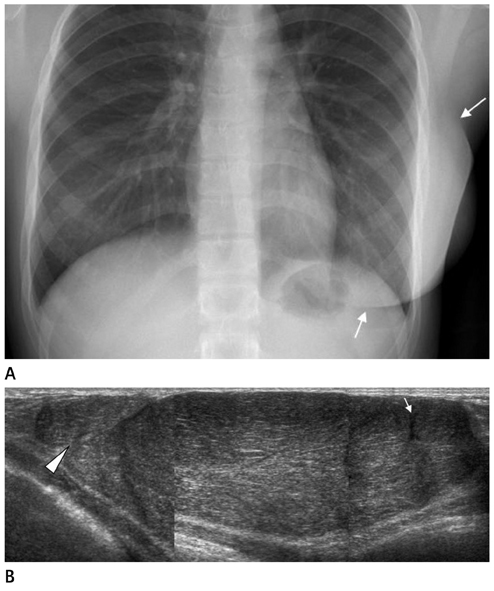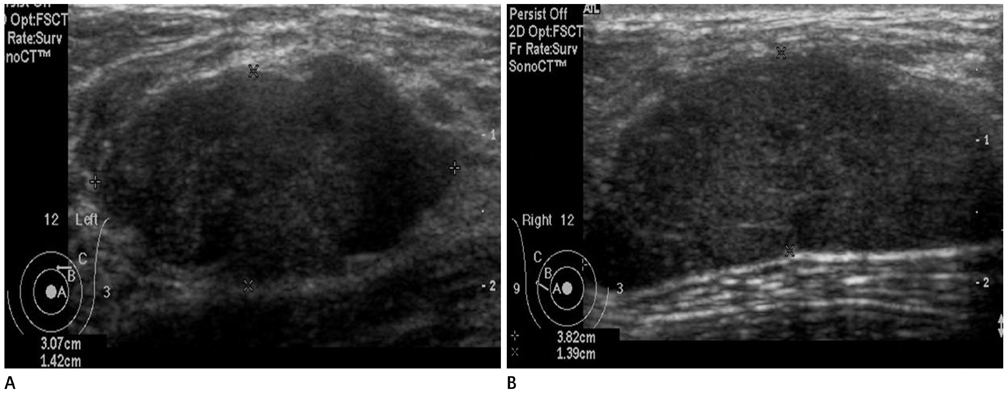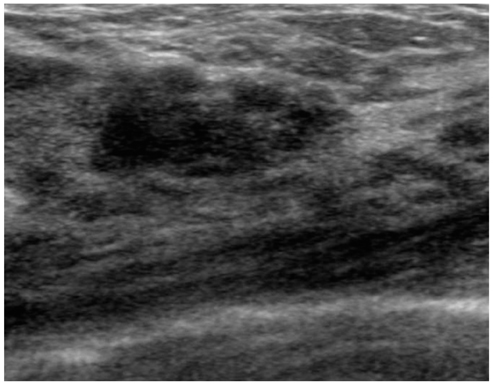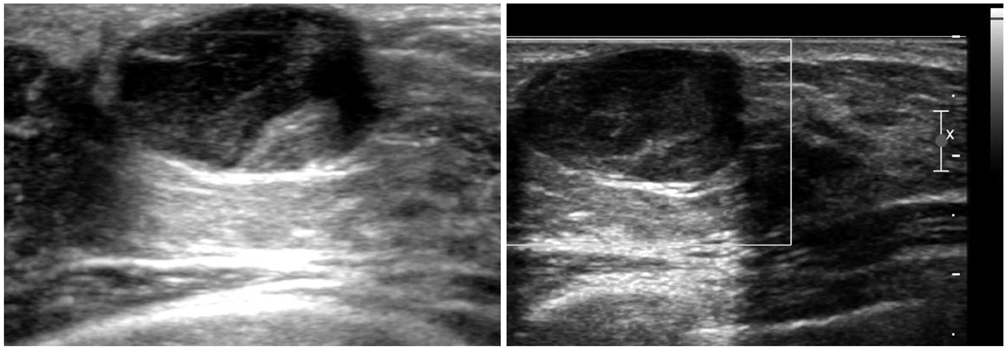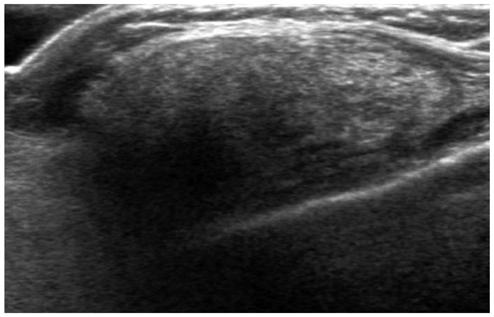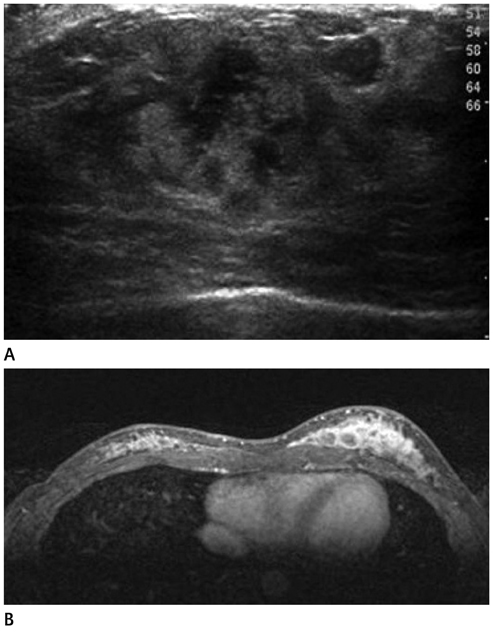J Korean Soc Radiol.
2013 Feb;68(2):141-151. 10.3348/jksr.2013.68.2.141.
Common and Uncommon Conditions of Breast Disease in Children and Adolescents: A Pictorial Review
- Affiliations
-
- 1Department of Radiology, Eulji University Hospital, Daejeon, Korea. kskim@eulji.ac.kr
- 2Department of Radiology, Dankook University Hospital, Cheonan, Korea.
- 3Department of Radiology, Asan Medical Center, University of Ulsan College of Medicine, Seoul, Korea.
- KMID: 2097992
- DOI: http://doi.org/10.3348/jksr.2013.68.2.141
Abstract
- The purpose of this study is to review various breast diseases in children and adolescents and to illustrate the sonographic findings. We reviewed the cases at our institution in order to identify breast disease in children and adolescent patients who underwent sonography and mammography. Breast disease in children and adolescents included developmental disturbance, infection, benign tumors and inherent defects. In contrast to adults, the radiologic findings of malignant breast conditions in pediatric populations have rarely been reported; however, we show ductal carcinoma in situ with juvenile fibroadenoma and rhabdomyosarcoma. During childhood and adolescence, the recognition and correct identification of physiologic breast development and specific lesions in breast entities on radiologic findings is most helpful in identifying and characterizing abnormalities and in guiding further investigation.
MeSH Terms
Figure
Reference
-
1. Bock K, Duda VF, Hadji P, Ramaswamy A, Schulz-Wendtland R, Klose KJ, et al. Pathologic breast conditions in childhood and adolescence: evaluation by sonographic diagnosis. J Ultrasound Med. 2005. 24:1347–1354. quiz 1356-1357.2. Venta LA, Dudiak CM, Salomon CG, Flisak ME. Sonographic evaluation of the breast. Radiographics. 1994. 14:29–50.3. Siegel MJ. Siegel MJ, editor. Chest. Pediatric sonography. 2002. 3rd ed. Philadelphia, PA: Lippincott Williams & Wilkins;201–211.4. Chung EM, Cube R, Hall GJ, González C, Stocker JT, Glassman LM. From the archives of the AFIP: breast masses in children and adolescents: radiologic-pathologic correlation. Radiographics. 2009. 29:907–931.5. Kopans DB. Breast Imaging. 1997. 2nd ed. Philadelphia, PA: Lippincott Williams & Wilkins;497–505.6. Stavros AT. Evaluation of the male breast. Breast Ultrasound. 2004. Philadelphia, PA: Lippincott Williams & Wilkins;712–714.7. Yitta S, Singer CI, Toth HB, Mercado CL. Image presentation. Sonographic appearances of benign and malignant male breast disease with mammographic and pathologic correlation. J Ultrasound Med. 2010. 29:931–947.8. Coffin CM. Stocker JT, Dehner LP, editors. The breast. Pediatric pathology. 2002. 2nd ed. Philadelphia, PA: Lippincott Williams & Wilkins;207–208.9. Goel NB, Knight TE, Pandey S, Riddick-Young M, de Paredes ES, Trivedi A. Fibrous lesions of the breast: imaging-pathologic correlation. Radiographics. 2005. 25:1547–1559.10. Rosai J. Rosai J, editor. Breast. Rosai and Ackerman's surgical pathology. 2004. 9th ed. St Louis, MO: Mosby;1769–1773.11. Cole-Beuglet C, Soriano RZ, Kurtz AB, Goldberg BB. Fibroadenoma of the breast: sonomammography correlated with pathology in 122 patients. AJR Am J Roentgenol. 1983. 140:369–375.12. Kronemer KA, Rhee K, Siegel MJ, Sievert L, Hildebolt CF. Gray scale sonography of breast masses in adolescent girls. J Ultrasound Med. 2001. 20:491–496.13. Baker KS, Monsees BS, Diaz NM, Destouet JM, McDivitt RW. Carcinoma within fibroadenomas: mammographic features. Radiology. 1990. 176:371–374.14. Vade A, Lafita VS, Ward KA, Lim-Dunham JE, Bova D. Role of breast sonography in imaging of adolescents with palpable solid breast masses. AJR Am J Roentgenol. 2008. 191:659–663.15. Yilmaz E, Sal S, Lebe B. Differentiation of phyllodes tumors versus fibroadenomas. Acta Radiol. 2002. 43:34–39.16. Liberman L, Bonaccio E, Hamele-Bena D, Abramson AF, Cohen MA, Dershaw DD. Benign and malignant phyllodes tumors: mammographic and sonographic findings. Radiology. 1996. 198:121–124.17. Greydanus DE, Matytsina L, Gains M. Breast disorders in children and adolescents. Prim Care. 2006. 33:455–502.18. Pettinato G, Manivel JC, Kelly DR, Wold LE, Dehner LP. Lesions of the breast in children exclusive of typical fibroadenoma and gynecomastia. A clinicopathologic study of 113 cases. Pathol Annu. 1989. 24(Pt 2):296–328.19. Chantra PK, Tang JT, Stanley TM, Bassett LW. Circumscribed fibrocystic mastopathy with formation of an epidermal cyst. AJR Am J Roentgenol. 1994. 163:831–832.20. Taira N, Aogi K, Ohsumi S, Takashima S, Kawamura S, Nishimura R. Epidermal inclusion cyst of the breast. Breast Cancer. 2007. 14:434–437.21. Crystal P, Shaco-Levy R. Concentric rings within a breast mass on sonography: lamellated keratin in an epidermal inclusion cyst. AJR Am J Roentgenol. 2005. 184:3 Suppl. S47–S48.22. Faul JL, Berry GJ, Colby TV, Ruoss SJ, Walter MB, Rosen GD, et al. Thoracic lymphangiomas, lymphangiectasis, lymphangiomatosis, and lymphatic dysplasia syndrome. Am J Respir Crit Care Med. 2000. 161(3 Pt 1):1037–1046.23. Brown LR, Reiman HM, Rosenow EC 3rd, Gloviczki PM, Divertie MB. Intrathoracic lymphangioma. Mayo Clin Proc. 1986. 61:882–892.24. Miyake H, Shiga M, Takaki H, Hata H, Onishi R, Mori H. Mediastinal lymphangiomas in adults: CT findings. J Thorac Imaging. 1996. 11:83–85.25. Weiss S, Goldblum J. Benign lipomatous tumors: Enzinger and Weiss's soft tissue tumors. 2001. 4th ed. St Louis, MO: Mosby;571–639.26. Kransdorf M, Murphey M. Lipomatous tumors. Imaging of soft tissue tumors. 1997. Philadelphia, PA: Saunders;57–101.27. Murphey MD, Carroll JF, Flemming DJ, Pope TL, Gannon FH, Kransdorf MJ. From the archives of the AFIP: benign musculoskeletal lipomatous lesions. Radiographics. 2004. 24:1433–1466.28. Hogge JP, Robinson RE, Magnant CM, Zuurbier RA. The mammographic spectrum of fat necrosis of the breast. Radiographics. 1995. 15:1347–1356.29. Soo MS, Kornguth PJ, Hertzberg BS. Fat necrosis in the breast: sonographic features. Radiology. 1998. 206:261–269.30. Sakorafas GH, Tsiotou AG. Ductal carcinoma in situ (DCIS) of the breast: evolving perspectives. Cancer Treat Rev. 2000. 26:103–125.31. Moon WK, Myung JS, Lee YJ, Park IA, Noh DY, Im JG. US of ductal carcinoma in situ. Radiographics. 2002. 22:269–280. discussion 280-281.32. Agrons GA, Wagner BJ, Lonergan GJ, Dickey GE, Kaufman MS. From the archives of the AFIP. Genitourinary rhabdomyosarcoma in children: radiologic-pathologic correlation. Radiographics. 1997. 17:919–937.33. Yang WT, Muttarak M, Ho LW. Nonmammary malignancies of the breast: ultrasound, CT, and MRI. Semin Ultrasound CT MR. 2000. 21:375–394.
- Full Text Links
- Actions
-
Cited
- CITED
-
- Close
- Share
- Similar articles
-
- Breast lesions during pregnancy and lactation: a pictorial essay
- Unexpected hyperechoic lesions of the breast and their correlations with pathology: a pictorial essay
- Ultrasonography of Various Thyroid Diseases in Children and Adolescents: A Pictorial Essay
- National Patterns and Characteristics in Pediatric Dental Emergency Visits for Dental Conditions
- Vestibular migraine of childhood





